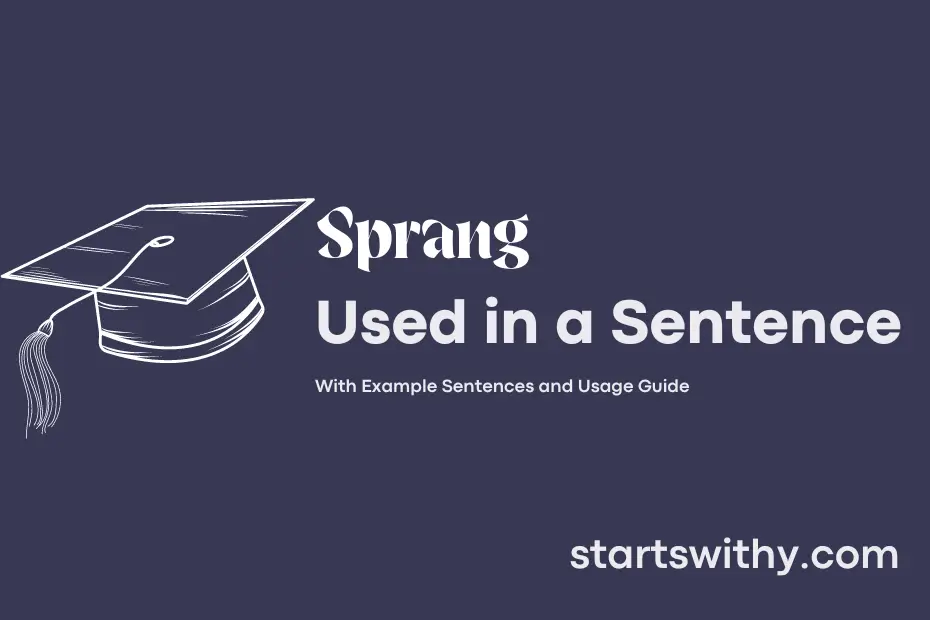When a sentence with “sprang” is used, it typically describes a sudden and swift movement or action. The word “sprang” signifies a quick and dynamic action, often involving a sudden burst of energy or force.
In writing, a sentence with “sprang” can add vigor and immediacy to a narrative or description. By incorporating this word, the writer can vividly convey a sense of sudden movement or growth within the story, engaging the reader and creating a more dynamic reading experience.
7 Examples Of Sprang Used In a Sentence For Kids
- The bunny sprang over the log.
- The frog sprang into the pond.
- The cat sprang onto the table.
- The squirrel sprang up the tree.
- The bird sprang out of its nest.
- The kangaroo sprang across the field.
- The ball sprang high into the air.
14 Sentences with Sprang Examples
- The idea sprang suddenly into her mind during the brainstorming session.
- Excitement sprang in the room as the college fest announcements were made.
- A sense of nostalgia sprang up as the final exams approached.
- An opportunity for a new internship sprang up out of nowhere.
- Motivation sprang from within as the deadlines for assignments neared.
- Laughter sprang easily among friends during the late-night study sessions.
- New friendships sprang up during the orientation week at college.
- Inspiration sprang from the motivational speech delivered by the guest speaker.
- A sense of pride sprang within him as he scored the highest marks in the class.
- The desire to explore new horizons sprang up after attending a career workshop.
- A debate sprang up in the classroom during a heated discussion on current affairs.
- Confidence sprang from within when she successfully completed her first project presentation.
- A sense of determination sprang up as he realized the importance of time management in college.
- Curiosity sprang in the group when a new subject was introduced in the syllabus.
How To Use Sprang in Sentences?
Sprang is a regular verb in English that is used to describe an action that happened suddenly or unexpectedly in the past. To use “sprang” correctly in a sentence, follow these easy steps:
-
Identify the subject: Determine the person or thing that performed the action. For example, “The cat” or “John.”
-
Choose the correct form: Since “sprang” is the past tense form of the verb “spring,” make sure you are referring to an action that occurred in the past.
-
Add the subject and the verb: Combine the subject with the past tense form of “spring” to form your sentence. For example, “The cat sprang onto the table” or “John sprang out of bed.”
-
Check the tense: Ensure that the surrounding context of your sentence is also in the past tense to maintain grammatical consistency.
Here are a few more examples of how to use sprang in a sentence:
- The athlete suddenly sprang into action during the race.
- The squirrel sprang from one tree to another with ease.
- When the alarm went off, she sprang out of bed in a panic.
Remember to practice using “sprang” in different sentences to become more comfortable with this verb tense. With time and practice, you will master using sprang effectively in your writing.
Conclusion
In conclusion, the sentences with “sprang” exemplify actions that are sudden, energetic, or unexpected. Whether describing someone springing into action or a surprise development that sprang up unexpectedly, the word conveys a sense of dynamism and spontaneity. Through these sentences, we see how “sprang” is used to vividly capture moments of quick movement or emergence. It adds a sense of urgency and liveliness to the narrative, making the actions described more impactful and engaging for the reader.
Overall, the sentences with “sprang” effectively depict moments of rapid response, growth, or change, emphasizing the immediacy and excitement of the events unfolding. By incorporating this word into their writing, authors can evoke a sense of motion and surprise, drawing readers into the scene with its energetic connotations.



